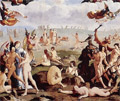Care for the here and the hereafter
In the Middle Ages all Christians hoped to enter the kingdom of heaven after their death but, as the church taught
them, only saints would be allowed to go straight to heaven. Hell for all eternity awaited those sinners who had
died without receiving absolution for their sins. Damnation was irrevocable. Even if one's sins had been absolved,
however, one still had to spend time in purgatory to atone for one's sins before being admitted to heaven.
A life of virtue and good deeds could improve one's chances of salvation. Charitable acts included giving to the
poor, the sick, and the church, either during one's lifetime or through bequests in one's will. In return the
recipients of these gifts were expected to secure their benefactors a shorter spell in purgatory and help them
attain heaven through masses and prayers for their souls. Do ut des ('I give so you may give') was the
principle on which medieval memorial culture - and society - was based.
Yet memorial culture comprised not only religious-liturgical components. A grand tomb monument that featured the
ancestral coats of arms was a way to present oneself and one's descendents as the rightful rulers of one's
territory (political-social component). One could also add an epitaph listing the heroic deeds and juridical
authority of one's dynasty (historical and juridical component). Furthermore, one could donate money to feed the
poor on condition that they say a prayer at one's grave (social component).
Many medieval tomb monuments still name the deceased whom they commemorate. Names were essential because it was
through the mention of their names that the dead retained a presence within the communities to which they
belonged (e.g. a convent or guild). The care for the here and now was thus closely linked to the care for
the hereafter.
|



|
Disclaimer:
2011: web design by Charlotte Dikken (UU). This website was tested and works on Internet Explorer, Opera and Firefox
and is best viewed on a fully maximized screen. Some of the features on this site use JavaScript.

Last updated on: 7 May 2014.
|
|
|